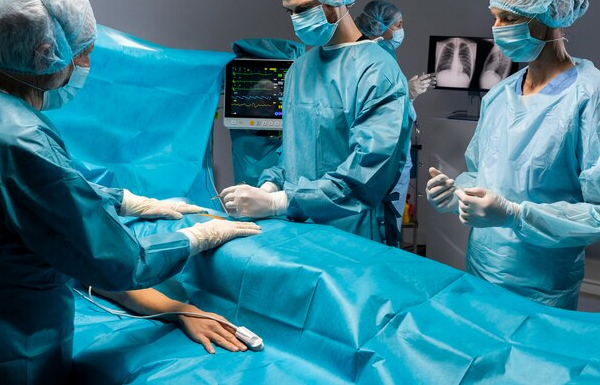Dr. Sankar Dasmahapatra
Laparoscopic Surgery Specialist in Kolkata, India
DGO, MS, Fellowship in Gynaecological Lap Surgery (Sydney -Australia)
Consultant Gynaecologist & Obstetrician
Infertility Specialist & Lapaoscopic Surgeon
DGO, MS, Fellowship in Gynaecological Lap Surgery (Sydney -Australia)
Consultant Gynaecologist & Obstetrician
Infertility Specialist & Lapaoscopic Surgeon
by Dr. Sankar Dasmahapatra

Is laparoscopic surgery safe or open surgery?
Open surgery provides direct access and better visibility but comes with a larger incision and longer recovery. Laparoscopy, on the other hand, offers smaller incisions, faster recovery, and less noticeable scars, but may not be suitable for all cases.”
Has anyone got pregnant after laparoscopy?
While it's true that every case is unique, the good news is that it is quite rare for laparoscopic surgery to adversely affect a woman's fertility. In many cases, it may actually improve the odds of conception.
Do gynecologists perform laparoscopy?
Today, operative laparoscopy is routinely used by gynecologists to perform a multitude of procedures, including hysterectomies and incontinence procedures, and for the diagnosis and treatment of gynecologic malignancies
Can I get pregnant after a laparoscopy?
For some women, who have undergone a laparoscopy to remove fibroids or endometriotic lesions, repair a hydrosalpinx, unblock a fallopian tube, or reverse a tubal ligation, the surgery actually increases the chances of getting pregnant. However, there are some cases where laparoscopy may affect your ability to conceive.
What is a gynecological laparoscopy?
A gynaecological laparoscopy is a keyhole procedure that allows your surgeon to examine your pelvis (lower abdomen) including the fallopian tubes, ovaries and womb.
What are the benefits of laparoscopy in gynecology?
Advantages of Laparoscopic Surgery: Reductions in days of postoperative hospital stay. Less postoperative pain and less consumption of analgesic medication. More rapid reintegration of patients to their work. Better cosmetic result.
What is the Fothergill operation?
The Manchester operation, Manchester repair or simply Fothergill operation is a technique used in gynaecologic surgeries. It is an operation for uterine prolapse by fixation of the cardinal ligaments. Its purpose is to reduce the cystourethrocele and to reposition the uterus within the pelvis.
What is a Manchester-Fothergill Procedure?
It is a surgery that restores normal support of the uterus without removing the uterus. It is used commonly in Europe for this purpose. During this surgery, the surgeon detaches the ligaments that support the uterus and removes the lower part of the cervix.
What is Manchester's procedure?
It is an operation to support the womb (uterus) by shortening the cervix (neck of womb) and using the tissues around it to give support without removing the upper part of the womb. It is often referred to as a Manchester repair.
What is another name for Manchester repair?
Vaginal sacrospinous hysteropexy with sutures. Manchester repair (also called the Fothergill operation).
The Manchester operation, Manchester repair or simply Fothergill operation is a technique used in gynaecologic surgeries. It is an operation for uterine prolapse by fixation of the cardinal ligaments. Its purpose is to reduce the cystourethrocele and to reposition the uterus within the pelvis. The major steps of the intervention are listed below:
1) Preliminary dilatation and curettage
2) Amputation of cervix
3) strengthening the cervix by suturing cut end of Mackenrodt ligament in front of cervix
4) Anterior colporrhaphy
5) Posterior colpoperineorrhaphy
6) High amputation of cervix during this procedure may cause cervical incompetence.
Understanding hysteroscopic complications and how they are managed
Some possible complications of hysteroscopy may include:
1) Infection.
2) Bleeding.
3) Pelvic inflammatory disease.
4) Tears in the uterus (rare) or damage to the cervix.
5) Complications from fluid or gas used to expand the uterus.
What is the most common complication of hysteroscopy?
Uterine perforation is the commonest complication of hysteroscopic surgery. Uterus can be perforated during dilation or with hysteroscope.
What are the don'ts after a hysteroscopy?
After the hysteroscopy,it's normal to have some vaginal bleeding and cramping for a few days after the procedure, but you should report any severe pain, heavy bleeding, discharge or fever to us. Don't douche or have intercourse for two weeks after a hysteroscopy.
How long does it take for the uterus to heal after a hysteroscopy?
You will probably be able to go back to most of your normal activities in 1 or 2 days. This care sheet gives you a general idea about how long it will take for you to recover. But each person recovers at a different pace.
How safe is a hysteroscopy?
Hysteroscopy is a very safe procedure. But there is a small risk of problems. The uterus or cervix can be punctured by the hysteroscope, you may have bleeding, or extra fluid may build up in your system. In very rare cases, hysteroscopy can cause life-threatening problems.
What are the symptoms after a hysteroscopy?
Recovering from a hysteroscopy It's normal to have pain, similar to period pain, for a couple of days after a hysteroscopy. Taking paracetamol, ibuprofen or your usual period pain medicine should help. You may also have some bleeding, or spots of blood (spotting), for up to a week. Use sanitary pads not tampons.